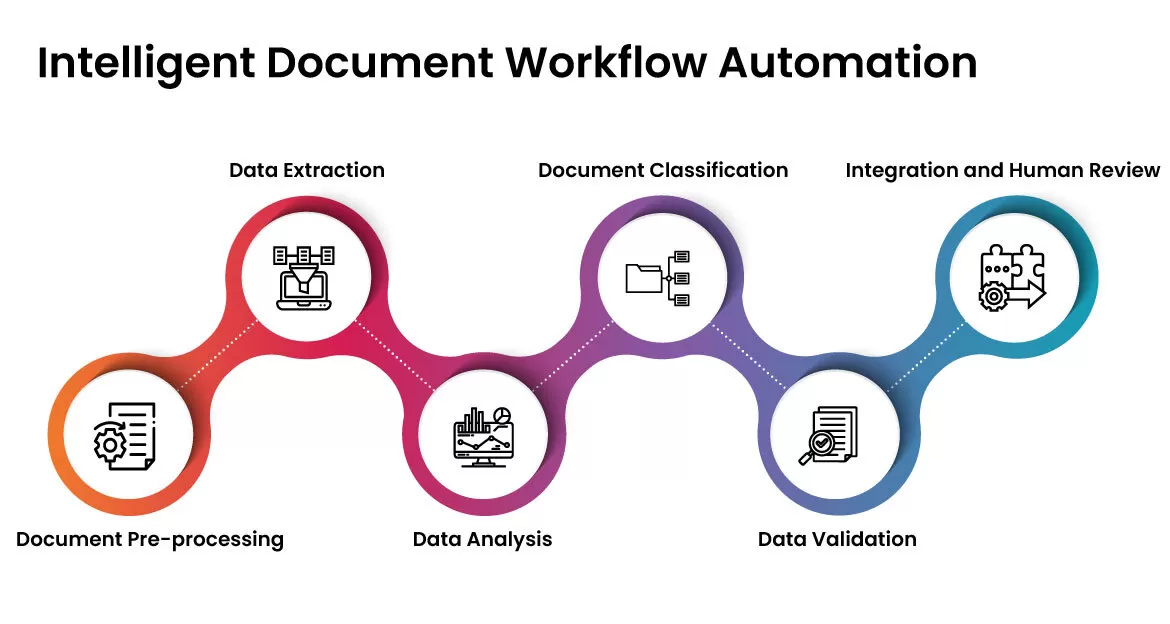
Any business that has a high volume of manual document processing can get an average savings of 25-40% with intelligent document processing (IDP). While this might sound like an exaggeration, it really is not. iTech has worked with businesses across industries for the integration of document workflow automation and the use of appropriate automation tools can reduce up to 80% of the workload
Examples of Efficiency Improvement with IDP across Industries
Implementing automated document extraction solutions can bring numerous benefits to businesses, including efficiency improvements, improved accuracy, and cost savings.
- Processing invoices automatically: Manually processing a high volume of invoices in the manufacturing industry can be both time-consuming and prone to human error. Intelligent document processing can extract data from both digital and physical documents, info such as supplier info, items, quantities, and pricing and it can be directly linked with the ERP system for payment processing – if needed, with human supervision.
- Processing Healthcare documentation: Electronic health records (EHR), lab reports, etc. are examples of voluminous patient information that is handled on a daily basis by healthcare practitioners. AI-driven document processing solutions like DocExtract from iTech use AI and ML that help in reducing up to 70% of human data entry.
- Automating Bill of Lading in Logistics and Supply Chain: Bills of lading are critical in the supply chain flow as they contain important shipping details such as cargo description, quantity as well as weight, and consignee details. Document workflow automation can lead to a 50% reduction in processing time.
- Analyzing contract data in the legal industry: Law firms have to deal with reams of contract information. Manually processing contracts to extract important data such as clauses, terms, and duties can be done automatically and speeds up the review process.
These are just a few use cases of improving business efficiency by automating document extraction and processing. Its application covers diverse industries.

A step-to-step guide on calculating ROI from Intelligent Document Processing (IDP)?
There are 3 primary areas where businesses can calculate ROI from document processing automation.
- Increased business efficiency and cost saving
- Improved customer retention
- Ability to bring improved or new solutions to market faster
Conducting a return on investment ROI analysis can help assess the financial impact of such implementation from a business perspective. Here’s a step-by-step guide on how to perform an ROI analysis for implementing automated document extraction solutions.
Let’s walk through an example of an ROI analysis for implementing an automated document extraction solution in a hypothetical insurance company.
1.Identify the problem and set objectives
Start by clearly defining the problem or pain points that the automated document extraction solution aims to address. For example, businesses may struggle with manual data entry, time-consuming document processing, or errors in data extraction.
A large insurance provider receives thousands of claim forms daily. Currently, the claims department manually processes these forms, resulting in a high volume of manual data entry, time-consuming processing, and errors in data extraction.
The objectives of implementing the automated document extraction solution are to reduce manual data entry time, increase data accuracy, improve processing speed, and enhance compliance with regulatory requirements.
2. Identify the costs associated with implementing the solution
This includes both direct costs (such as software licensing fees, hardware requirements, and implementation services) and indirect costs (such as training and maintenance).
Hypothetically, let us say the costs associated with implementing the solution for the insurance carrier include software licensing fees ($10,000), hardware requirements ($5,000), and implementation services ($8,000). Additionally, there will be ongoing maintenance costs of $2,000 per year.
Total Cost = $10,000 + $5,000 + $8,000 + $2,000 = $25,000
3. Calculate Benefits
Quantify the potential benefits that the automated document extraction solution can bring to the business. These benefits may include
a. Time Savings: Estimate the amount of time savings by automating the document extraction process. Consider the number of documents processed, the average time per document, and the reduction in processing time achieved with automation.
Currently, it takes an average of 5 minutes to manually process each claim form. With the automated solution, this time can be reduced to 1 minute per form. Assuming 1,000 forms are processed daily, the time saved is:
Manual processing time = 5 minutes/form * 1,000 forms = 5,000 minutes/day
Automated processing time = 1 minute/form * 1,000 forms = 1,000 minutes/day
Time saved = 5,000 minutes/day – 1,000 minutes/day = 4,000 minutes/day
b. Labor Costs: Assuming an average hourly rate of $20 for manual data entry personnel, the labor cost savings can be calculated as follows:
Labor cost per minute = $20/hour / 60 minutes = $0.33/minute
Labor cost savings = Time saved * Labor cost per minute
= 4,000 minutes/day * $0.33/minute
= $1,320/day
c. Error Reduction: Currently, the error rate in manual data entry is estimated at 5%. With the automated solution, the error rate can be reduced to 1%. The cost of errors includes the time spent on error correction, customer dissatisfaction, and potential compliance penalties.
Current error cost = 5% * 1,000 forms * $50/error = $2,500/day
Automated error cost = 1% * 1,000 forms * $50/error = $500/day
Error reduction = Current error cost – Automated error cost
= $2,500/day – $500/day
= $2,000/day
d. Increased Throughput: With the automated solution, the insurance company can process an additional 200 forms per day due to increased efficiency. Assuming an average claim value of $100 per form, the additional revenue generated is:
Additional revenue = 200 forms * $100/form = $20,000/day
Consider Intangible Benefits: In addition to quantifiable benefits, consider intangible benefits that may be challenging to measure but still contribute to the overall value of the solution. These could include improved data quality, enhanced customer satisfaction, or better decision-making capabilities.
4. Decision-Making
Evaluate the ROI results in conjunction with other factors, such as implementation complexity, scalability, and alignment with business strategies. This analysis will help make an informed decision about whether to proceed with the implementation of the automated document extraction solution.
Remember that an ROI analysis provides a financial perspective on the investment, but it’s essential to consider other non-financial factors that may influence the decision-making process.
Finally, software solutions in intelligent document processing must provide the business with a definite return on investment. Speak to our senior team of experts for a demo on DocExtract and to discuss your business requirements.

